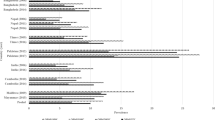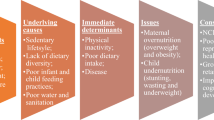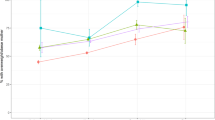Abstract
Background/objectives
There is little research on the association between socioeconomic status (SES) and the familial co-existence of maternal over and child under-nutrition (MOCU). Most of these studies conducted in the Latin American countries. Therefore, we intended to further this important area of query by exploring the relationship between SES and the dual burden of MOCU in Bangladesh.
Subjects/methods
We used data from the 2014 Bangladesh Demographic Health Survey (BDHS). The analyses were based on the responses of 5687 mother–child pairs. We focused standard of living (hereafter referred to as wealth) as a measure of SES. We determined MOCU if there were an undernourished child and an overweight mother in the same household.
Results
Maternal overweight and MOCU prevalence is higher among the wealthier segment whereas prevalence of child under-nutrition is higher among the poorest segment of the households. The relative risk of a household having MOCU increased by the factors of 2.84 (confidence interval (CI) = 1.58–5.12) among households with richest bands of wealth compared to the poorest category. Household from the medium (Relative risk ratio (RRR) = 1.87, 95% CI = 1.07–3.28) and richer SES groups (RRR = 2.56, 95% CI = 1.39–4.69) had increased chance for MOCU as compared to the household from poorest SES group.
Conclusions
As opposed to findings from other Latin American countries, the prevalence of MOCU in Bangladesh is higher in the wealthiest households. Findings of our study therefore suggest that overweight prevention programs in wealthier households of Bangladesh need to think out the possibility that their focus households may also include underweight persons.
This is a preview of subscription content, access via your institution
Access options
Subscribe to this journal
Receive 12 print issues and online access
$259.00 per year
only $21.58 per issue
Buy this article
- Purchase on Springer Link
- Instant access to full article PDF
Prices may be subject to local taxes which are calculated during checkout


Similar content being viewed by others
References
Roger S & Claudia R The double burden of malnutrition: a review of global evidence. HNP Discussion Paper Series. The International Bank for Reconstruction and Development, the World Bank, Washington, DC; 2012.
World Health Organization. Double burden of malnutrition.. Geneva: WHO; 2016. http://www.who.int/nutrition/double-burden-malnutrition/en/ Accessed at
Sara D Are stunted child/overweight mother pairs a distinct entity or a statistical artifact? Demographic and Health Surveys, 1991-2009. Rollins School of Public Health of Emory University, 2012.
NIPORT Mitra and Associates, Macro International. Bangladesh Demographic and Health Survey 2004. Dhaka, Bangladesh and Calverton, Maryland, USA: National Institute of Population Research and Training, Mitra and Associates, and Macro International.
NIPORT Mitra and Associates, Macro International. Bangladesh Demographic and Health Survey 2014. Dhaka, Bangladesh and Calverton, Maryland, USA: National Institute of Population Research and Training, Mitra and Associates, and Macro International.
Keino S, Plasqui G, Ettyang G, van den Borne B. Determinants of stunting and overweight among young children and adolescents in sub-Saharan Africa. Food Nutr Bull. 2014;35:167–78.
Fernald LC, Neufeld LM. Overweight with concurrent stunting in very young children from rural Mexico: prevalence and associated factors. Eur J Clin Nutr. 2007;61:623–2.
Tzioumis E, Adair LS. Childhood dual burden of under- and over-nutrition in low- and middle-income countries: a critical review. Food Nutr Bull. 2014;35:230–43.
Piernas C, Wang D, Du S, Zhang B, Wang Z, Su C. The double burden of under- and over nutrition and nutrient adequacy among Chinese preschool and school-aged children in 2009-11. Eur J Clin Nutr. 2015;69:1323–9.
Lee J, Houser RF, Must A, de Fulladolsa PP, Bermudez OI. Socioeconomic disparities and the familial coexistence of child stunting and maternal overweight in Guatemala. Econ Hum Biol. 2012;10:232–41.
Barquera S, Peterson KE, Must A, Rogers BL, Flores M, Houser R, et al. Coexistence of maternal central adiposity and child stunting in Mexico. Int J Obes. 2007;31:601–7.
Garrett JL, Ruel MT. Stunted child-overweight mother pairs: prevalence and association with economic development and urbanization. Food Nutr Bull. 2005;26:209–21.
Sarmiento OL, Parra DC, González SA, González-Casanova, Forero AY, Garcia J. The dual burden of malnutrition in Colombia. Am J Clin Nutr. 2014;100(suppl):1628S–35S.
Doak CM, Adair LS, Bentley M, Monteiro C, Popkin BM. The dual burden household and the nutrition transition paradox. Int J Obes. 2005;29:129–36.
Bassett MN, Romaguera D, Giménez MA. Prevalence and determinants of the dual burden of malnutrition at the household level in Puna and Quebrada of Humahuaca, Jujuy, Argentina. Nutr Hosp. 2014;29:322–30.
Jef LL, Jean-Pierre H, Teresa G, Ruel MT. Maternal education mitigates the negative effects of higher income on the double burden of child stunting and maternal overweight in rural Mexico. J Nutr. 2014;144:765–70.
Geok L, Zalilah MS. Dual forms of malnutrition in the same households in Malaysia-a case study among Malay rural households. Asia Pac J Clin Nutr. 2003;12:427–38.
Subramanian SV, Ichiro K, George D. Income inequality and the double burden of under- and over nutrition in India. J Epidemiol Community Health. 2007;61:802–9.
Oddo VM, Rah JH, Semba RD, Sun K, Akhter N, Sari M, et al. Predictors of maternal and child double burden of malnutrition in rural Indonesia and Bangladesh. Am J Clin Nutr. 2012;95:951–8.
Jehn M, Brewis A. Paradoxical malnutrition in mother-child pairs: untangling the phenomenon of over- and under-nutrition in underdeveloped economies. Econ Hum Biol. 2009;7:28–35.
Khan AM Income Inequality in Bangladesh. Paper presented at the 19 th Biennial Conference “Rethinking Political Economy of Development” Of the Bangladesh Economic Association Institution of Engineers, Bangladesh. Dhaka, 2014.
Bangladesh Bureau of Statistics. Bangladesh Population and Housing Census 2011. Statistics and Informatics Division (sid), Ministry of Planning Government of the People’s Republic of Bangladesh, 2014
WHO. Nutrition Landscape Information System (NLIS) country profile indicators: interpretation guide. Department of Nutrition for Health and Development (NHD), Geneva, Switzerland, 2010. Available at: http://www.who.int/nutrition/nlis_interpretation_guide.pdf Department of Nutrition for Health and Development (NHD), Geneva, Switzerland
WHO. WHO Global Database on Body Mass Index (BMI). Department of Nutrition for Health and Development (NHD), Geneva, Switzerland, 2013. Available at: http://www.who.int/bmi/index.jsp.
Rahman M, Nakamura K, Masashi K. Socioeconomic differences in the prevalence, awareness, and control of diabetes in Bangladesh. J Diabetes Complicat. 2015;29:788–93.
Mackenbach JP, Stirbu I, Roskam AR. Socioeconomic inequalities in health in 22 European countries. N Engl J Med. 2008;358:2468–81.
Zou G. A modified poisson regression approach to prospective studies with binary data. Am J Epidemiol. 2004;159:702–6.
Popkin BM, Adair LS, Ng SW. Global nutrition transition and the pandemic of obesity in developing countries. Nutr Rev. 2012;70:3–21.
Popkin BM. Global nutrition dynamics: The world is shifting rapidly toward a diet linked with noncommunicable diseases. Am J Clin Nutr. 2006;84:289–98.
Grijalva-Eternod CS, Wells JC, Cortina-Borja M, Salse-Ubach N, Tondeur MC, Dolan C, et al. The double burden of obesity and malnutrition in a protracted emergency setting: A cross-sectional study of Western Sahara refugees. PLoS Med. 2012;9:e1001320.
Bangladesh Institute of Research and Rehabilitation in Diabetes, Endocrine, and Metabolic Disorder. Dietary guidelines for Bangladesh. BIRDEM, Dhaka, 2013. Available at: http://www.fao.org/3/a-as880e.pdf
Islam N Wahidul MH A multivariate analysis of the selection factors of carbonated soft drinks in Bangladesh. Proceedings of the iamb 2009 Conference, New Orleans, Louisiana, USA. 2009.
McDonald SD, Han Z, Mulla S, Beyene J, Knowledge Synthesis Group. Overweight and obesity in mothers and risk of preterm birth and low birth weight infants: systematic review and meta-analyses. BMJ. 2010;341:c3428. 20
Ni KA, Shankar A, Nunik, Besral B, Jahari AB, Endang A. Low birth weight was the most dominant predictor associated with stunting among children aged 12–23 months in Indonesia. BMC Nutr. 2017;3:16.
Rahman MS, Howlader T, Masud MS, Rahman ML. Association of low-birth weight with malnutrition in children under five years in Bangladesh: do mothers education, socio-economic status, and birth interval matter? PLoS ONE. 2016;11:e0157814. 29
Aitsi-Selm A. Households with a stunted child and obese mother: trends and child feeding practices in a middle-income country, 1992–2008. Matern Child Health J. 2015;19:1284–91.
Asfaw A. Micronutrient deficiency and the prevalence of mothers’ overweight/obesity in Egypt. Econ Hum Biol. 2007;5:471–83.
Kimani-Murage EW, Muthuri SK, Oti SO, Mutua MK, van de Vijver S, Kyobutungi C. Evidence of a double burden of malnutrition in urban poor settings in Nairobi, Kenya. PLoS ONE. 2015;10:e0129943.
Sally L. Over and under: the role of urbanization on the double burden of nutrition in developing countries. Prognosis. 2015;6:12–9.
Crush J, Bruce F, Milla M. Rapid urbanization and the nutrition transition in Southern African. Urban Food Security Series No. 7. Queen’s University and AFSUN: Kingston and Cape Town, 2011.
Joseg S, Prakash S. The nutrition transition to 2030. Why developing countries are likely to bear the major burden. Food Econ. 2005;2:150–66.
Cervantes VGA, LoÂpez-Espinoza A, Moreno AGM, Cañedo CL, Miramontes EHV, Housni FE, et al. Effect of the number of interruptions in the pattern of sedentary behavior on energy expenditure. Rev Mex de Trastor Aliment. 2016;7:46–55.
Biswas T, Uddin MJ, Mamun AA, Pervin S, Garnett P. Increasing prevalence of overweight and obesity in Bangladeshi women of reproductive age: Findings from 2004 to 2014. PLoS ONE. 2017;12:e0181080. 28
Giashuddin MS, Kabir M. Duration of breast-feeding in Bangladesh. Indian J Med Res. 2004;119:267–72.
ESPGHAN Committee on Nutrition1, Agostoni C, Braegger C, Decsi T, Kolacek S, Koletzko B, et al. Breast-feeding: a commentary by the ESPGHAN Committee on Nutrition. J Pediatr Gastroenterol Nutr. 2009;49:112–25.
Rahman M, Berenson AB. Accuracy of current body mass index obesity classification for white, black and Hispanic reproductive-age women. Obstet Gynecol. 2010;115:982–8.
Acknowledgements
We are thankful to the MEASURE DHS for serving us with the 2014 BDHS data set.
Authors contributions
M.R. conceived the study and committed to statistical analysis, and wrote the manuscript. K.S. and S.H.E. contributed to reviewing of the article.
Author information
Authors and Affiliations
Corresponding author
Ethics declarations
Conflict of interest
The authors declare that they have no conflict of interest.
Rights and permissions
About this article
Cite this article
Hauqe, S.E., Sakisaka, K. & Rahman, M. Examining the relationship between socioeconomic status and the double burden of maternal over and child under-nutrition in Bangladesh. Eur J Clin Nutr 73, 531–540 (2019). https://doi.org/10.1038/s41430-018-0162-6
Received:
Revised:
Accepted:
Published:
Issue Date:
DOI: https://doi.org/10.1038/s41430-018-0162-6
This article is cited by
-
A multilevel analysis of the triple burden of malnutrition in Indonesia: trends and determinants from repeated cross-sectional surveys
BMC Public Health (2023)
-
Association between maternal stature and household-level double burden of malnutrition: findings from a comprehensive analysis of Ethiopian Demographic and Health Survey
Journal of Health, Population and Nutrition (2023)
-
Inequalities in the prevalence of double burden of malnutrition among mother–child dyads in India
Scientific Reports (2023)
-
How does mode of delivery associate with double burden of malnutrition among mother–child dyads?: a trend analysis using Bangladesh demographic health surveys
BMC Public Health (2022)
-
Trade and dietary preferences can determine micronutrient security in the United Kingdom
Nature Food (2022)



